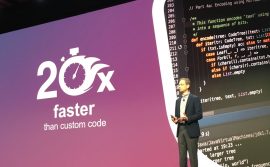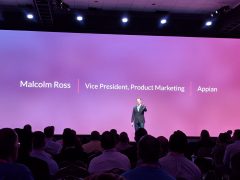Appian World 2018: Miami nice for drag and drop
Drag and drop will be key in reducing the pain and time for software users if Appian, a US-based provider of low-code applications, has its way.
At its Appian World 2018 global user conference at the Fontainebleau Hotel in Miami, spread over three days (23-25 April), the firm welcomed around 1,500 delegates for promos, tech talks and sophisticated schmoozing.
Like a wise investor mixing it up, Appian isn’t just involved in one sector. Financial services tech makes up around 30% of its business as it is also making money in such areas as life sciences, healthcare, and the public sector.
Over the first two days I had a chance to interview Appian’s top brass, look in on labs, and listen to speeches.
Matt Calkins, Appian’s CEO, used his presentation to say that every two years it wants to cut in half the amount of work for software users. Citing the oft-quoted Moore’s law, he explained: “Except instead of the size of the transistor it will be the amount of work it takes to build your application.”
Calkins said Appian would go for places requiring scripts, such as interface design. It plans more integrations, for example, with HTTP, the much-loved APIs and the correct use of SOAP. The latter being “simple object access protocol” used for messaging.
In his witty and lively speech, he announced Appian’s expanded artificial intelligence (AI) alliance for improved “intelligent automation” with KPMG; and the unveiling of its cloud-driven intelligent contact centre platform for financial services.
For that platform, much was made of how that works. Such as offering AI sentiment analysis and integrated connectivity to cloud cognitive and machine learning services.
Calkins quipped: “If you send us a mean letter, we will know.”
Calling on Chicago
Away from SOAP operas, Appian launched the latest version of its digital transformation platform for building software apps.
To support this, Appian got Chicago-based Options Clearing Corporation to chime in with some comments
“We deployed nine key risk mitigating applications on Appian in just 18 months,” said Denise Knabjian, OCC’s first VP of process innovation.
She added: “Appian is key to the flexible yet secure IT infrastructure we require given our designation as a systemically important financial market utility (SIFMU).”
I had a chance to talk with Knabjian at the event. She was “very pleased” with Appian because they needed automation and risk management quickly. Its “first step” was choosing low code as it offered “agility and development”.
OCC made a “rapid assessment” in selecting Appian. There was no vendor shortlist – just research via Gartner and Forrester to find the best match.
The look of lab
In a brief chat with Malcolm Ross, Appian’s VP of product marketing, he said its “differentiator” from the competition is its cloud architecture. Here it offers access to platforms such as Google, Amazon and Microsoft.
One of its clients he named was Florida-based First Republic Bank (FRB), which revamped some of its business functions – such as loans. In fact, the bank’s SVP of lending and VP of deposit sales and strategy were both at the event to show how Appian helped.
I also had the chance to sit in on two labs – one on the internet of things (IoT), the other on blockchain. As Ross pointed out, Appian does use this technology in supply chain management, where it integrates with Ethereum.
The blockchain lab was a good example of how Appian’s drag-and-drop software could be used. With some basic instructions, I could get an idea of how to build a web API in Appian’s blockchain. The software was easy on the eye and simple to use.
The presenter pointed out that its app is “agnostic” – so it “doesn’t care” about which blockchain it uses. As many others in fintech have said, he noted that the “industry is still trying to work out what to do” with blockchain.
The company says “hopefully” this code will be open source. We don’t know yet.
Digital gel
If you’re not familiar with Appian’s history or status quo, then last year it jumped on the tech bandwagon with a $75 million initial public offering. This saw plenty of analysts offer favourable views and called it a success.
Also in 2017, Appian was enlisted by Switzerland-based Vontobel Bank “to execute its digital transformation strategy across all business divisions”. While in February, Santander turned to Appian for its global enterprise process improvement plans.
In an interview with Guy Mettrick, Appian’s industry leader for financial services in EMEA, I did ask him for specifics on these two bank projects, but nothing would be shared. (Today [25 April], Vontobel will be discussing its project. So, there may be some updates from that.)
He calls Appian the “digital gel” and did cite Aviva as one of its clients. Last year, the UK insurer deployed Appian’s platform for its digital revamp. Appian said it created more than ten applications for automating processes.
To give you a flavour of what else it does, Mettrick said Appian is not involved in big data analytics and core banking systems do not run on its platform. For the latter, and importantly, it integrates with them, such as SAP.
In terms of plans in the EMEA region, he sees the company “being used for audits – because core banking systems are becoming more open – such as with the advent of PSD2”.
With regards to other banks that I asked Appian about over the two days, the firm wouldn’t go public on the names of some of the US ones it works with. However, the company did tell me off the record – and I’d say it has got an impressive roster of clients.
On fire
Right now, Appian reckons it’s in a good place and turned to Forrester to explain why.
In a speech by John Rymer, VP, principal analyst, Forrester, on “Beyond the Need for Speed: The Future of Low-Code Development”; he says the adoption of these platforms is “on fire”.
In terms of stats, Rymer gave reasons via year-on-year growth forecasts for low code. This year will see 45% growth, followed by a steady rise. Next year will see 50% and 2020 will reach 55%. His graph did show it will plateau out after that – but not a lot was said about this aspect.
Rymer notes that after the “great recession” companies began looking at growth again and there was an “added urgency” due to “digital disruptors” (such as Uber).
He explains that innovation was focused on customers and “people needed software fast”. They couldn’t wait and this era of impatience gave Appian a chance to step in with its solutions. Right place, right time.
To bring more joy to Appian’s world, Rymer said, for example, a large business would have thousands of processes of which “most are not automated”. In his view, “low code is quick delivery”.
I suppose you could argue what happens later when this demand potentially diminishes? When these are automated, then that market dries up. Fintech is also a fickle world. Firms may no longer want a quick fix, but go all languid and long term.
We’ll see, but for now Appian has captured a handy corner of the market, got some good clients, and has momentum on its side.
There will be a report later covering the event’s final day. Stay tuned low-code lovers.













































